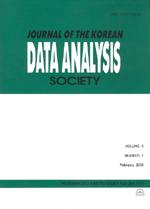결핵 치료 중 사망에 대한 다수준 분석
Multilevel analysis for tuberculosis mortality during treatment
- 한국자료분석학회
- Journal of The Korean Data Analysis Society (JKDAS)
- Vol.25 No.2
-
2023.04573 - 583 (11 pages)
-
DOI : 10.37727/jkdas.2023.25.2.573
- 55

결핵은 사회적 결정요인을 가지는 대표적 감염병으로 개인과 지역 수준의 영향요인을 가진다. 본 연구는 다수준 로지스틱 회귀분석을 활용하여 개인 수준과 지역 요인을 함께 고려한 분석을 시행하여 한국 결핵 PPM 협력체계가 도입된 초기 시기(2012~2015년)의 치료 중 사망에 영향을 주는 지역 요인을 파악하는 것이다. PPM 종합병원과 보건소, 의원을 치료기관으로 선택하면 지역 PPM 지원율에 따른 사망률의 차이를 나타내지 않았다. non-PPM 병원(기울기 0.016, p<0.001)과 non-PPM 종합병원(기울기 0.017, p<0.001)은 PPM 지원율이 높은 지역일수록 사망률이 더 높아지는 것으로 나타났다. PPM 병원을 치료기관으로 선택하면 PPM 지원율이 높은 지역일수록 사망률이 큰 수준으로 증가하였다(기울기 0.033, p<0.001). 소수의 대형병원 위주의 치료 체계를 채택한 제도적 상황으로 인하여 각 지역은 여건에 따라 지역 PPM 지원율이 다양하게 분포하게 되었고, 이에 따라 선택한 치료기관 종류는 다른 맥락을 만들어내었고 치료 중 사망률 차이로 이어지게 됨을 확인하였다.
Tuberculosis is an infectious disease with social determinants and is associated with individual and regional factors. In this study, multilevel logistic regression analysis was used to identify regional factors affecting mortality during treatment considering the individual level and regional level factors together in the early period (2012-2015) when the Korean tuberculosis PPM cooperation system was introduced. When PPM general hospitals, public health centers, and clinics were selected as treatment institutions, there was no difference in mortality according to regional PPM support rates. Non-PPM hospitals (slope 0.016, p<0.001) and non-PPM general hospitals (slope 0.017, p<0.001) showed a higher mortality rate in regions with higher PPM support rates. When PPM hospitals were selected as treatment institutions, the higher the PPM application rate, the higher the mortality rate (slope 0.033, p<0.001). Due to the institutional situation of adopting a treatment system centered on a small number of large hospitals, each region has a diverse distribution of regional PPM coverage depending on the circumstances, and accordingly, the type of healthcare providers selected creates a different context and leads to a difference in mortality during treatment.
1. 서론
2. 연구방법
3. 연구결과
4. 결론
References
(0)
(0)